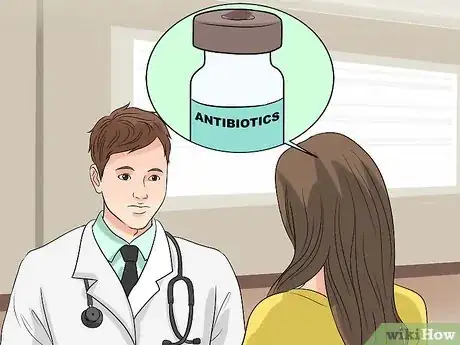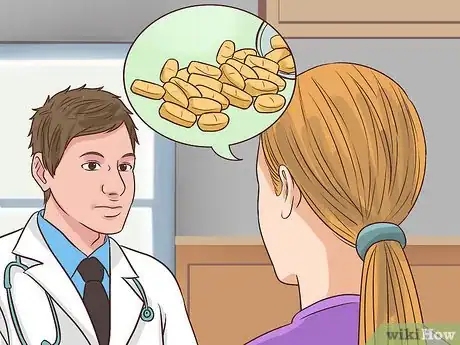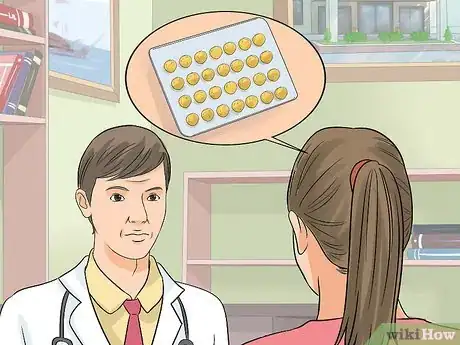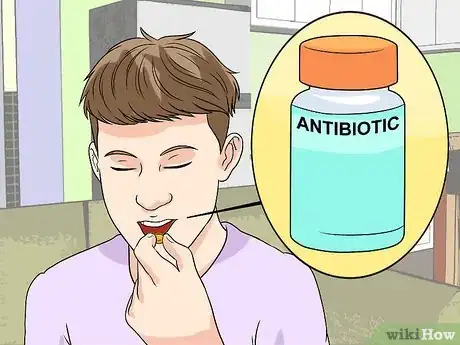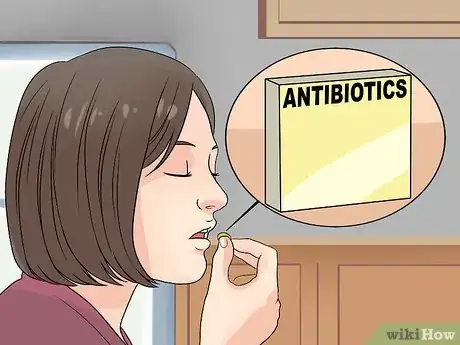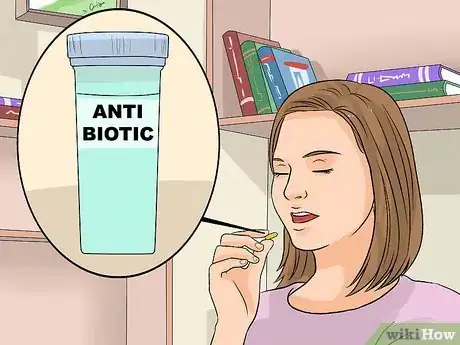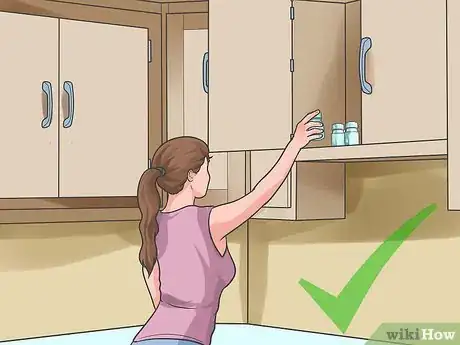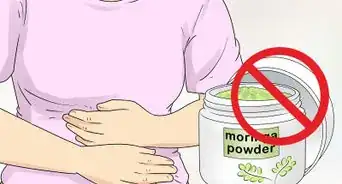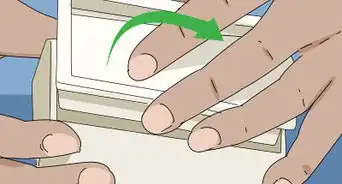This article was medically reviewed by Janice Litza, MD. Dr. Litza is a board certified Family Medicine Physician in Wisconsin. She is a practicing Physician and taught as a Clinical Professor for 13 years, after receiving her MD from the University of Wisconsin-Madison School of Medicine and Public Health in 1998.
This article has been viewed 21,692 times.
Amoxicillin is an antibiotic that is often prescribed for infections like tonsillitis, bronchitis, pneumonia, and other bacterial conditions.[1] To take amoxicillin safely, make sure you consult with your doctor first and get a prescription for this medication. Then, take the medication as directed so you can recover properly from the infection. If you notice any adverse side effects or issues while on amoxicillin, see your doctor right away for guidance.
Steps
Getting a Prescription from Your Doctor
-
1Discuss your medical history with your doctor. If you have a history of allergies, asthma, hay fever, or hives, tell your doctor. You should also disclose if you have liver or kidney disease. Amoxicillin can interact negatively with your immune system if you have these conditions.[2]
- If you are pregnant, breastfeeding, or planning to become pregnant, tell your doctor. They may prescribe a lower dosage of amoxicillin to ensure it does not affect your unborn baby.
- If you are on birth control, tell your doctor. Amoxicillin can reduce the effectiveness of birth control, so you may need to use another form of contraception while on the medication.
-
2Tell your doctor about any other medications you are taking. Disclose all the medications you are on, such as pharmaceuticals and other antibiotics. Tell your doctor if you are taking nutritional supplements, vitamins, or herbal medicines. This can help them monitor your progress on amoxicillin and watch for any adverse side effects.[3]
- If you are on a lot of other medications, make a list and give it to your doctor. They can then use the list to determine your dosage of amoxicillin.
Advertisement -
3Confirm you are not allergic to penicillin. If you have had any type of allergic reaction to penicillin in the past, even as an infant or child, avoid taking amoxicillin. Because these medicines are similar, you may be allergic to amoxicillin in addition to penicillin.[4]
-
4Discuss your dosage of amoxicillin with your doctor. Your doctor should be very clear on how much of the medication you should take each day. The standard dosage is 3 times a day, every 8 hours. However, your dosage may be more or less depending on your condition, age, and weight.[5]
- Your dosage should be printed on the label of the medication so you know exactly how much to take each day.
Taking Amoxicillin Safely
-
1Get amoxicillin in tablet form if you don’t mind swallowing pills. Look for chewable tablets if you prefer breaking up the tablets before swallowing them. You may opt for tablets or capsules if you do not want to take the time to measure and pour out liquid amoxicillin.[6]
- Amoxicillin capsules are often recommended for adults who are comfortable swallowing pills several times a day.
-
2Choose amoxicillin in liquid form if you don’t mind measuring out the medication. You will need to use a dosing syringe or a dose-measuring spoon to ensure you are taking the correct amount of amoxicillin. The liquid can be placed right on your tongue or mixed into water, juice, or milk.[7]
- Liquid amoxicillin is often recommended for children, as it is usually easier for them to swallow than tablets or capsules.
-
3Take amoxicillin at the same time every day. Schedule in a time to take amoxicillin in your calendar or day planner. Try to have the medication at the same time each day so you take the correct dosage. Set a reminder on your phone or computer so you don't forget.[8]
- For example, if you are supposed to take amoxicillin every 8 hours, 3 times a day, you may set a timer for every 8 hours so you can take the medication at 6 am, 2 pm, and 10 pm.
-
4Have amoxicillin with water or juice. If you are taking amoxicillin in liquid form, shake the bottle well before measuring out the dosage. Consume tablet or liquid amoxicillin with water or juice to mask the taste and make them easier to digest.[9]
- Swallow the tablets whole, unless they are chewable. If they are chewable, chew them completely before swallowing them.
-
5Check the label to determine if you can have amoxicillin with food. Some brands of amoxicillin are okay to take with a small amount of food or within 1 hour of eating. Other brands should be consumed on an empty stomach. Read the label on the medication to determine if you should have it with or without food.[10]
- You can also ask your doctor for advice on whether or not you can have amoxicillin with food.
-
6Have any missed doses as soon as you remember. If you forgot to take a dose of amoxicillin and it is close to the time for your second dose, skip the first dose. Do not double up or take more than recommended to make up for missing a dose.[11]
-
7Take amoxicillin until your prescription runs out. Do not stop taking amoxicillin if you start to notice your symptoms are going away. Take the medication until you have had all the prescribed doses. If you stop too soon, your symptoms may come back. Also, taking less than a full prescription may cause you to be resistant to amoxicillin and other common antibiotics.[12]
-
8Store the amoxicillin correctly. Keep amoxicillin tablets at room temperature in a dry spot in your home, such as a high shelf or a cupboard. Make sure the tablets are not exposed to heat, moisture, or direct light. Keep liquid amoxicillin in the fridge. Make sure it stays cold, but does not freeze.[13]
- You should also keep the tablets in a cupboard or high shelf so they are out of reach of children and pets.
- Throw out any unused liquid amoxicillin after 10 days in the garbage in a sealed bag.
Doing Follow up Care
-
1See your doctor if you experience upset stomach, vomiting, or diarrhea. Amoxicillin can cause you to experience stomach issues and mild diarrhea. But if your symptoms become severe, see your doctor for guidance. They may reduce your dosage to keep your symptoms mild and manageable.[14]
-
2Seek immediate medical care if you have hives, seizures, or severe fatigue. These are all symptoms of a possible overdose of amoxicillin. Your doctor may suggest lowering your dosage or switching you to a different medication.[15]
-
3Have probiotics after you are finished taking amoxicillin. Probiotics can help to balance your gut after you have taken antibiotics. It can also help to prevent thrush on your mouth or vaginal yeast infections. Ask your doctor for advice on how to take probiotics once you are finished taking amoxicillin.
- You can buy probiotics over the counter at your local pharmacy or health food store.
- You can also add foods to your diet that contain probiotics, like yogurt or kefir.
References
- ↑ https://www.nhs.uk/medicines/amoxicillin/
- ↑ https://medlineplus.gov/druginfo/meds/a685001.html
- ↑ https://www.nhs.uk/medicines/amoxicillin/
- ↑ https://www.drugs.com/amoxicillin.htm
- ↑ https://patient.info/medicine/amoxicillin-for-infections
- ↑ https://www.drugs.com/amoxicillin.html
- ↑ https://www.nhs.uk/medicines/amoxicillin/
- ↑ https://patient.info/medicine/amoxicillin-for-infections
- ↑ https://medlineplus.gov/druginfo/meds/a685001.html
- ↑ https://www.nhs.uk/medicines/amoxicillin/
- ↑ https://medlineplus.gov/druginfo/meds/a685001.html
- ↑ https://patient.info/medicine/amoxicillin-for-infections
- ↑ https://www.drugs.com/amoxicillin.html
- ↑ https://www.drugs.com/amoxicillin.html#side-effects
- ↑ https://medlineplus.gov/druginfo/meds/a685001.html
- ↑ https://patient.info/medicine/amoxicillin-for-infections
About This Article
To take amoxicillin, take the recommended dosage at the same time every day. If you don't like the taste, try taking it with water or juice so it's easier to get down. Continue to take amoxicillin until your prescription runs out, even if you start feeling better, since you need a full course to prevent your symptoms from coming back. For more advice from our Medical co-author, like how to prevent and recognize complications when taking amoxicillin, scroll down!


